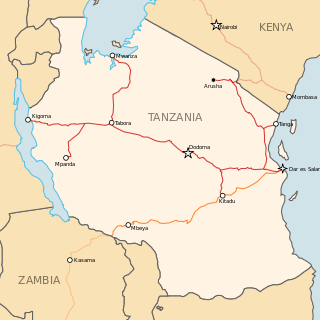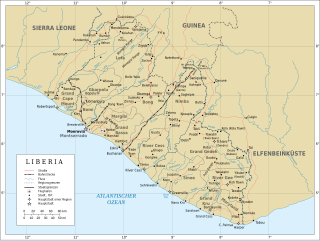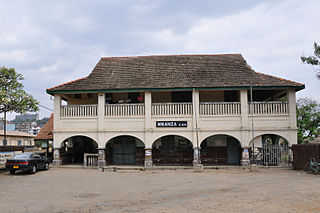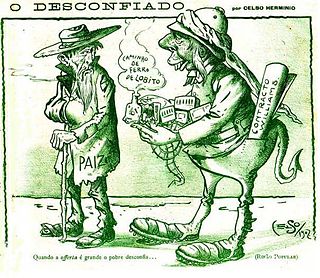
The Benguela Railway is a Cape gauge railway line that runs through Angola from west to east, being the largest and most important railway line in the country. It also connects to Tenke in the Democratic Republic of the Congo (DRC), and to the Cape to Cairo Railway.

Zinga is a town on the Oubangui River in the Central African Republic. The town stretches roughly 1 km long and 300 m wide. It is known for its wooden buildings and as a ferry port, from which boats sail to Bangui and Brazzaville.

A portage railway is a short and possibly isolated section of railway used to bypass a section of unnavigable river or between two water bodies which are not directly connected. Cargo from waterborne vessels is unloaded, loaded onto conventional railroad rolling stock, carried to the other end of the railway, where it is unloaded and loaded onto a second waterborne vessel. A portage railway is the opposite of a train ferry.

The Congo–Ocean Railway links the Atlantic port of Pointe-Noire with Brazzaville, a distance of 502 kilometres (312 mi). It bypasses the rapids on the lower Congo River; from Brazzaville, river boats are able to ascend the Congo River and its major tributaries, including the Oubangui River to Bangui.

Rail transport in Tanzania is conducted by two companies. It has historically used narrow gauge trackage, but planning and construction of new standard gauge lines is underway as of 2017.

Rail transport in Madagascar is primarily operated by Madarail. There are two unconnected systems having a total length of 855 km (531 mi), as of 2023, all metre gauge, 1,000 mm. The northern railway is concessioned to Madarail. Since April 2022 Madarail has been 100% owned by the Madagascan state. The southern line, Fianarantsoa-Côte-Est railway is a parastatal line.

Rail transport is provided in the Democratic Republic of the Congo by the Société Nationale des Chemins de Fer du Congo (SNCC), the Société commerciale des transports et des ports (SCTP) (previously Office National des Transports until 2011), and the Office des Chemins de fer des Ueles (CFU).
This is a list of planned, or proposed, high-speed rail projects by country. Although a number of countries have conducted preliminary feasibility studies, many lines are eventually shelved or postponed due to high costs; only a few nations are building high-speed rail lines. Planned lines are separated here from lines under construction, and some countries have both. High-speed rail is public transport by rail at speeds over 200 km/h (125 mph).

Portos e Caminhos de Ferro de Moçambique is a state-owned company that oversees the railway system of Mozambique and its connected ports.
There are several planned railway lines in Rwanda, including a line to Tanzania. Historical railways are limited to three industrial railways.

Sudan has 4,725 kilometers of narrow-gauge, single-track railways. The main line runs from Wadi Halfa on the Egyptian border to Khartoum and southwest to El-Obeid via Sennar and Kosti, with extensions to Nyala in Southern Darfur and Wau in Western Bahr al Ghazal, South Sudan. Other lines connect Atbara and Sennar with Port Sudan, and Sennar with Ad-Damazin. A 1,400-kilometer line serves the Al Jazirah cotton-growing region. There are plans to rehabilitate rail transport to reverse decades of neglect and declining efficiency. Service on some lines may be interrupted during the rainy season.
Up to 2012 Chad had no rail system. Two lines are planned to Sudan and Cameroon from the capital, with construction expected to start in February 2016 and be complete in 4 years.

The history of rail transport in Liberia began shortly after World War II, when the Freeport of Monrovia was completed, with limited rail access. It had been developed by American military forces.

The history of rail transport in Mozambique began in the latter years of the nineteenth century.

Rail transport in Tanzania began in the late 19th century.
A railway system existed in Mauritius from the 1860s until 1964. In 1956 the decision was made to close the railway due to unprofitability. At this time, Mauritius Government Railways had 146 km (91 mi) of 1,435 mm track and 47 locomotives. Freight transport continued until 1964 when the railway was scrapped.

South Sudan does not have an extensive rail system. The current rail infrastructure, which was constructed between 1959–1962, and was left over from the previous Sudan government, is in a serious state of disrepair. It consists of a 248 kilometers (154 mi) narrow-gauge, single-track line that connects Babonosa (Sudan) with the city of Wau in South Sudan. The line was left in poor condition after the Second Sudanese Civil War after several parts of it were mined; the line was fully rehabilitated with United Nations funds.

The history of rail transport in Angola began during the nineteenth century, when Angola was a colony of Portugal. It has involved the construction, operation and destruction of four separate, unconnected, coast-to-inland systems, in two different gauges. Operations on three of those systems have been largely restored; the other system has been closed.

The history of rail transport in Cameroon began at around the turn of the twentieth century.

The history of rail transport in Malawi began shortly after the turn of the twentieth century.

















